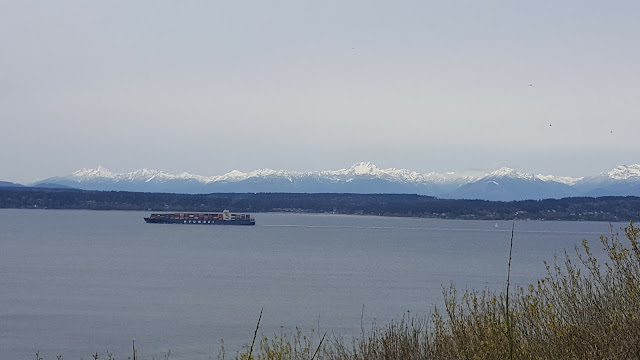4/24/17
5:10 pm
After a two-week hiatus from my site, I am astounded by
recent changes and how the setting has progressed into spring. The leaves of
the canopy shine a bright yellow-green in the sunlight, finally graced by our
star’s warmth and UV rays. While studying the canopy-- particularly, the new
leaves-- of the almost pure stand of red alder, I came to a realization: the
very dominant tree that I’m seeing is not Alnus
rubra like I’ve alleged. The leaves don’t even remotely resemble the
elliptic, toothed leaves of the red alder, but instead have the characteristic
5-lobed shape like that on the Canadian flag. Also, the stand lacked and lacks
catkins that would have appeared before the leaves if it was a red alder stand.
So, I conject that these trees are Big Leaf Maple, which is found in places
similar to Magnolia Bluff: dry/moist hillsides that have been cleared/logged at
low to middle elevations (Pojar 45) (Alden 106).
 |
| Photo of my site that I will be repeating henceforth. If you look closely, you'll notice the maple leaves on the trees. |
Walking to my site was notably more difficult than it was in
the past weeks. The trail-side shrubs have drastically increased in height and
are encroaching on the trail. I am going to take some photos and try to
identify them, but I identified one type of plant immediately by touch. After
only a quick bit of contact my hand was burning and had numerous white spots
surrounded by a hot redness: a sign of stinging nettle (Urtica dioica).
 |
| Stinging Nettle |
Nearly the entire ground is covered up to one foot
in plants, shrubs, and ferns. One of them appears to be some kind of blackberry
or bramble due to the ovular shape of its compound leaves and its thorniness.
There are a couple more that I will hope to identify from the photos I took. The only conifer in the vicinity I have identified as a Douglas Fir. From a distance I could not tell, and even as I was next to it I struggled for a moment, as the only indicator was its characteristically gnarled, lichened bark.
There are a couple more that I will hope to identify from the photos I took. The only conifer in the vicinity I have identified as a Douglas Fir. From a distance I could not tell, and even as I was next to it I struggled for a moment, as the only indicator was its characteristically gnarled, lichened bark.
However, I found a fallen branch
that had conical tips and same-sized needles which, along with a fallen cone,
gave it away.
 |
| Doug Fir competing in the Maple Grove |
I scoured the area around my site for lichens and fungi
and I am not finding very many different types. There is one distinct grayish lichen and a handful of others that are a bit greener or whiter. Below are all the lichen and fungi I found, which unfortunately includes no mushrooms:
Although I spent over an hour looking around the forest for various lichens, I came up short in finding diversity. I think this could be attributed to the fact that I hadn't attended the fungi/lichen lecture yet when I took my notes and photos, so I probably overlooked many lichen, mistaking them for moss or something of the like. However, I am pretty confident in my ability to recognize most mushrooms, so I am rather surprised by their scarcity. I think that could be attributed to the fact that my site has very sandy soil and is situated very close to the Sound, because in my past experiences I've usually seen fungi in wet, dense, and old forests.
 |
| This was the only photo that I definitively took of a fungus. It doesn't look like a mushroom, as it lacks the distinctive cap and spore releasing structure of a mushroom, and as such I honestly struggle to describe it. It's bright white, especially around the edges, and is grayer towards the center of its circular shape. I found this patch of fungus about 3 feet above ground on a Douglas Fir near my site. I'm curious as to what the black part of the image is, as it seems it could be a fungus or maybe simply fire scars from years past. However, the smoothness of these portions lead me to believe the former. |
Although I spent over an hour looking around the forest for various lichens, I came up short in finding diversity. I think this could be attributed to the fact that I hadn't attended the fungi/lichen lecture yet when I took my notes and photos, so I probably overlooked many lichen, mistaking them for moss or something of the like. However, I am pretty confident in my ability to recognize most mushrooms, so I am rather surprised by their scarcity. I think that could be attributed to the fact that my site has very sandy soil and is situated very close to the Sound, because in my past experiences I've usually seen fungi in wet, dense, and old forests.












Comments
Post a Comment